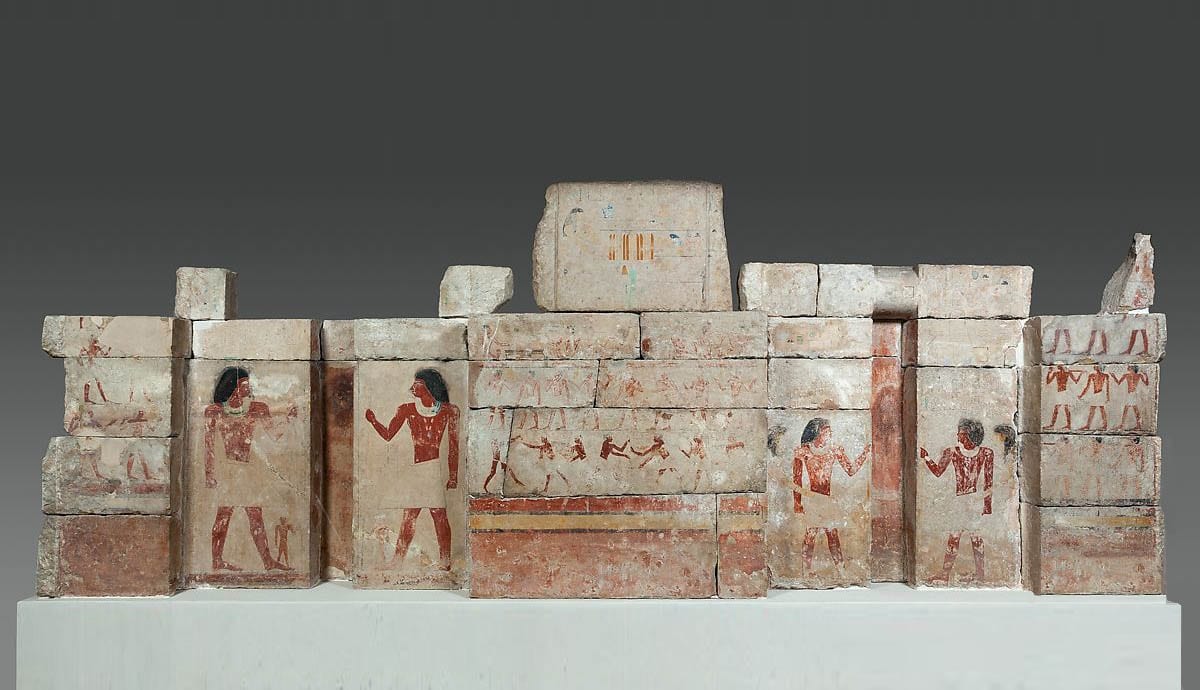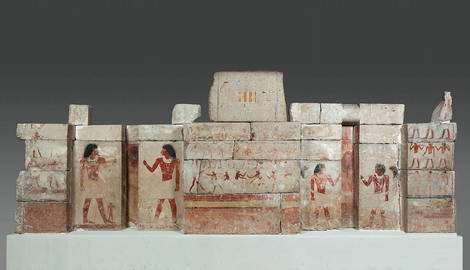
The third dynasty marked the beginning of Old Kingdom Egypt which lasted until roughly the sixth dynasty, from ca. 2686-2181 BC. It was an incredibly dynamic period in Egyptian history, a time where many earlier practices, concepts, and models developed into highly influential structures that impacted and guided much of the rest of Egyptian history. Read on to find out more about the dynasties of Old Kingdom Egypt and the achievements realized therein.
Old Kingdom Egypt Third Dynasty: A Period of Transition

It is rather difficult to find a clear distinction between the Early Dynastic Period and The Old Kingdom, especially since the ancient Egyptians themselves did not appear to do so. Nevertheless, most contemporary scholars agree that Dynasty 3 began with a king called Netjerikhet, later known as Djoser. To some, this dynasty is also traditionally included in the period of Old Kingdom Egypt because of the connection between Djoser’s pyramid, the first-ever constructed in Egypt, and the building efforts of the Fourth Dynasty.
Key developments in monumental building, politics, religious practices, and a centralized government rooted in Memphis were all departures from the earlier ways, which indicated that the third dynasty marked the beginning of a new period in Egyptian history. However, today many scholars view Dynasty 3 as more of a transitional phase linked closer to the Early Dynastic Period than the Old Kingdom.
The Step Pyramid Of Djoser

Djoser’s funerary complex, created by the great architect Imhotep, is characteristic of the kind of cultural and architectural developments that took place during his reign. Prior to this innovation, mastabas (bench-shaped tombs) and other structures were made out of mudbrick. The complex became the earliest stone structure in Egypt with the 205-foot-tall step pyramid at its center surrounded by temples, courtyards, shrines, and priestly living quarters, which served as the blueprint from which many projects in future dynasties drew their inspiration.
However, despite the fact that Djoser’s pyramid was made of stone—a completely new innovation—it still utilized Early Dynastic techniques. Imhotep stacked a series of mastabas atop one another to form the pyramidal shape as opposed to a ‘true’ pyramid. Additionally, many of the cultural, religious, and political advances still shared more similarities with Early Dynastic methods. Thus, scholars are still divided in their opinions about which era this dynasty belongs to, though no one can deny that it was a transitional period that witnessed the progression of many techniques and innovations that influenced art and architecture for the rest of Egyptian history and even today.
The Fourth Dynasty: Age Of The Pyramids

The 4th dynasty is considered to be the “golden age” of Old Kingdom Egypt. Due to the relative peace of the 3rd dynasty, the next ruling era was a time of social and political prosperity that allowed for the pursuit of more artistic and cultural leisures, including massive construction projects. Sneferu, the founder of the 4th dynasty, commissioned a series of building experiments that led to the evolution from Djoser’s step pyramid to the smooth-sided ‘true’ pyramids that have come to epitomize Egyptian architecture in modern memory.
King Sneferu’s Pyramids

The attempt to build his first pyramid at Meidum was rather disastrous. The outer foundation was made of sand instead of rock and the inner design layers were severely flawed, which compromised the stability of the pyramid and caused the outer layers to collapse. Think of sheets of ice falling off a rooftop!
Sneferu’s second pyramid at Dahshur, about 42 kilometers (26 miles) from Cairo, is commonly known as the Bent Pyramid, possibly because the steepness of the original angle began to show signs of structural instability, forcing the builders to adopt a shallower angle to avoid a collapse like that of the Meidum pyramid.
Sneferu’s third pyramid was an unmitigated success, earning its title as the first true pyramid of ancient Egypt. Unfortunately, its gentle slope made it easy for robbers to steal the white limestone outer casing, revealing the red limestone beneath.
The Pyramids of Giza

King Khufu, the second ruler of Dynasty 4, was known as Cheops by the Greeks and is best remembered for his Great Pyramid at Giza, the only one of the seven wonders of the ancient world that has survived to the present day. Until the construction of the Lincoln Cathedral in 1311 AD, Khufu’s creation was the tallest man-made structure on earth!
Also, despite popular imagination, these pyramids were not in fact built by slaves but by skilled Egyptian craftsmen and hired laborers. They were even paid with common wages of bread and beer! Herodotus and the Greeks painted him as a cruel autocrat, however primary sources have shown that his people admired him. During his reign, Old Kingdom Egypt grew wealthier through military campaigns, trade, and dam construction.

After his death, he was succeeded by Djedefre, his son but not his appointed heir. After a brief reign of about 8 years, his younger brother, Khafre, ascended to the throne. His ruling strategies were very similar to his father’s; he followed Khufu’s policies and nepotistic model of government. During his reign, the second largest pyramid was built in addition to a recumbent lion bearing his own face—the famed Great Sphinx. Although this pyramid appears to be taller than Khufu’s, it was actually built on bedrock 10 meters (33 foot) higher than the base of his father’s construction. The remnants of the outer casing of Khafre’s monument can be seen at the top of the pyramid—the rest were either repurposed for the construction of other later monuments or stolen.
Upon Khafre’s death, his son, Menkaure, was the next ruler of the 4th dynasty. Although his pyramid (ca. 2490 BC) is the smallest of the three main pyramids at Giza, the surrounding mortuary temple was much more complex, including a chapel, a valley temple, several statues, the mortuary temple itself, and a large basalt sarcophagus. Most unfortunately, the coffin was removed from the pyramid in the late 1830s and placed on a ship to be rehoused at the British Museum in London, but the ship was lost and Menkaure’s sarcophagus now lies at the bottom of the Mediterranean Sea.

Overall, Dynasty 4 of Old Kingdom Egypt experienced the general standardization of the elements of pyramid building. It also realized a new relationship between Ra, the primary sun god, and the king. Since around the 2nd dynasty, the ruler was viewed as a king of living king on earth. In the 4th dynasty, the relationship was more similar to that of a father and son, emphasized by the application of the title “Son of Ra”, which reduced their status from god to son of god.
Even still, at this point the king was still all-powerful and remained at the center of all governmental policies. Many of the high officials were closely related to the king in some way, and many of their mastabas were planned around the Giza pyramids, suggesting that they created a link between themselves and the king in order to make it into the afterlife. The kings were devoting enormous resources to the construction of these monumental architectural structures, but the temples and shrines became increasingly under the control of the priests who operated inside them.
The Fifth Dynasty of Old Kingdom Egypt: Religious Expansion

Several major social and cultural changes occurred in the 5th dynasty that marked an important turning point in Old Kingdom Egypt. It was known for the expansion of the solar cult of Ra. Beginning with Userkaf, the first king of this dynasty, several kings possessed his name within theirs and they focused their monumental building projects at Abusir with the construction of sun temples. This building type was indicative of the diminishing role of the king. At this point in the 5th dynasty, Ra was worshipped directly by the people through the offices of the priesthood; the king’s divine authoritative role as the direct representative of the god was lessened.
In addition to holding the responsibility of serving the gods, Egyptian priests controlled the taxes that were facilitated through temples. From the reigns of Neferirkare (ca. 2446-2438 BC) to Niussere (ca. 2420-2389 BC) these priests grew in power at the expense of the throne. Although the king still representative of the gods on earth and his title commanded a certain amount of esteem, his power and respect was slowly waning. Unlike in the previous dynasty, Dynasty 5 high officials progressively came from elite private families, and the increased size and complexity of their mastabas reflected their influence.

By the time the penultimate ruler of Dynasty 5, Djedkare Isesi (ca. 2381-2353 BC), rose to the throne, he realized the extent of priestly power and reformed the bureaucracy and the priesthood so as to maintain a more stable economy. He rejected the practice of building a sun temple and reduced the number of priests that took care of the mortuary complexes. He also decentralized the government at Memphis in order to lessen the costs of the bureaucracy that had emerged during the 4th and earlier 5th dynasties of Old Kingdom Egypt. Unfortunately for Djedkare Isesi, this move placed greater power in the hands of local officials. This resulted in the giving of more power to regions where local priests already had enough influence to make private deals with nomarchs and other governmental administrators, making the king’s earlier attempts to remove power from the priesthood all but irrelevant.
The Sixth Dynasty: The Decline of Old Kingdom Egypt

By the time that the 6th dynasty was established, royal power had already drastically weakened. During the reign of the first king, Teti I, nomarchs and high officials were creating more elaborate tombs than the nobility. The leadership at this stage of Old Kingdom Egypt was quickly deteriorating; especially during the nearly 100-year reign of Pepi II (ca. 2246-2152 BC) the Old Kingdom collapsed. He outlived all of his successors to the throne and seemed to have been a relatively ineffective king, especially in his later years.
When no strong leadership emerged to reunite the government, the end of Dynasty 6 was nigh. Civil war and a massive drought were the final blows. Local officials took it upon themselves to take care of their own communities; they felt no personal ties or loyalty to what was left of the Egyptian state. The Old Kingdom came to an end, and Egypt moved into the era known as the First Intermediate Period.








